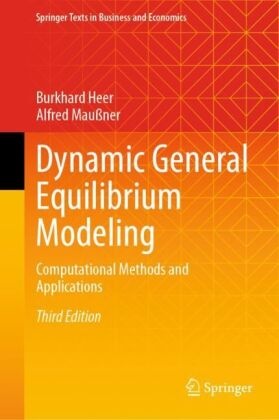
Dynamic General Equilibrium Modeling - Computational Methods and Applications
| Verlag | Springer |
| Auflage | 2024 |
| Seiten | 912 |
| Format | 23,5 cm |
| Gewicht | 1578 g |
| Artikeltyp | Englisches Buch |
| Reihe | Springer Texts in Business and Economics |
| ISBN-10 | 303151680X |
| EAN | 9783031516801 |
| Bestell-Nr | 03151680A |
Contemporary macroeconomics is built upon microeconomic principles, with its most recent advance featuring dynamic stochastic general equilibrium models. The textbook by Heer and Maußner acquaints readers with the essential computational techniques required to tackle these models and employ them for quantitative analysis. This third edition maintains the structure of the second, dividing the content into three separate parts dedicated to representative agent models, heterogeneous agent models, and numerical methods. At the same time, every chapter has been revised and two entirely new chapters have been added.
The updated content reflects the latest advances in both numerical methods and their applications in macroeconomics, spanning areas like business-cycle analysis, economic growth theory, distributional economics, monetary and fiscal policy. The two new chapters delve into advanced techniques, including higher-order perturbation, weighted residual methods, and solut ions to high-dimensional nonlinear problems. In addition, the authors present further insights from macroeconomic theory, complemented by practical applications like the Smolyak algorithm, Gorman aggregation, rare disaster models and dynamic Laffer curves. Lastly, the new edition places special emphasis on practical implementation across various programming languages; accordingly, its accompanying web page offers examples of computer code for languages such as MATLAB®, GAUSS, Fortran, Julia and Python.
Inhaltsverzeichnis:
Part I: Representative Agent Models: Basic Models.- Perturbation Methods: Framework and Tools.- Perturbation Methods: Solutions.- Perturbation Methods: Model Evaluation and Applications.- Weighted Residuals Methods.- Simulation-Based Methods.- Discrete State Space Value Function Iteration.- Part II: Heterogenous Agent Models: Computation of Stationary Distributions.- Dynamics of the Distribution Function.- Overlapping Generations Models with Perfect Foresight.- OLG Models with Uncertainty.- Part III: Numerical Methods: Linear Algebra.- Function Approximation.- Differentiation and Integration.- Nonlinear Equations and Optimization.- Difference Equations and Stochastic Processes.
